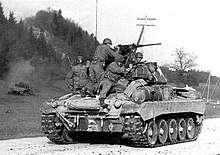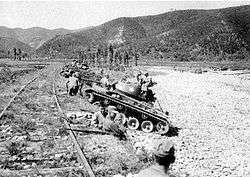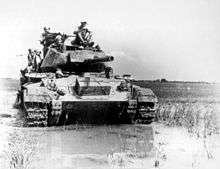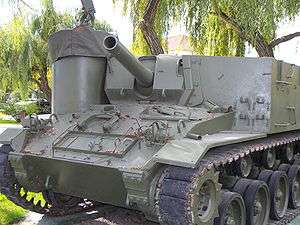M24 Chaffee
The M24 Chaffee (officially Light Tank, M24) is an American light tank used during the later part of World War II; it was also used in post–World War II conflicts including the Korean War, and by the French in the War in Algeria and the First Indochina War. In British service it was given the service name Chaffee after the United States Army General Adna R. Chaffee Jr., who helped develop the use of tanks in the United States armed forces. M24s were mostly removed from U.S. and NATO armies by the 1960s, but remained in service with some Third World countries.
| Light Tank, M24 | |
|---|---|
A preserved M24 of the Royal Netherlands Army | |
| Type | Light tank |
| Place of origin | United States |
| Service history | |
| In service | 1944–1953 (U.S. Army) |
| Used by | United States and 28 others; see Operators |
| Wars | |
| Production history | |
| Manufacturer | |
| Produced | 1944–August 1945 |
| No. built | 4,731 |
| Specifications | |
| Mass | 40,500 lb (20.3 short tons; 18.4 t)40,500 lb (18.37 metric tons) |
| Length | 18 ft 3 in (5.56 m) including gun 16 ft 6 in (5.03 m) excluding gun |
| Width | 9 ft 10 in (3 m) |
| Height | 9 ft 1 in (2.77 m) |
| Crew | 5 (commander, gunner, loader, driver, assistant driver/radio operator) |
| Armor | 0.40–1.50 in (10–38 mm) |
Main armament | 75 mm Gun M6 in Mount M64 48 rounds |
Secondary armament |
|
| Engine | Twin Cadillac Series 44T24 220 hp (160 kW) (164 kW) at 3,400 rpm (total) |
| Power/weight | 12 hp (8.9 kW) / tonne |
| Transmission | Hydramatic 8 speeds forward, 4 reverse |
| Suspension | Torsion bar |
| Ground clearance | 1 ft 6 in (0.46 m) |
| Fuel capacity | 110 US gal (420 l) |
Operational range | 100 mi (160 km) |
| Maximum speed | 35 mph (56 km/h) |
Development and production history
British combat experience in the North African campaign identified several shortcomings of the M3 Stuart light tank, especially the performance of its 37 mm cannon. A 75 mm gun was experimentally fitted to a Howitzer Motor Carriage M8 – an M3 tank with a larger turret – and trials indicated that a 75 mm gun on the M5 light tank development of the M3 was possible. The M3/M5 design was dated though, and the 75 mm gun reduced storage space.[1]
The T7 light tank design, which was initially seen as a replacement, grew in weight to more than 25 short tons taking it out of the light tank classification, and so was designated as the Medium Tank M7. The weight increase without increased power gave it unsatisfactory performance; the program was stopped in March 1943 to allow standardization on a single medium tank – the M4 medium.[2][1] This prompted the Ordnance Committee to issue a specification for a new light tank, with the same powertrain as the M5A1 but armed with a 75 mm gun.[3]
In April 1943, the Ordnance Corps, together with Cadillac (who manufactured the M5), started work on the new project, designated Light Tank T24. The powerplant and transmission of the M5 were used together with some aspects of the T7.[1] Efforts were made to keep the weight of the vehicle under 20 tons. The armor was extremely light and was sloped to maximize effectiveness. The turret was 25 mm thick with a 38 mm thick gun mantlet. The glacis plate was 25 mm thick. Side hull armor thickness varied: the frontal section was 25 mm thick but the rear third of the armor (which covered the engine compartment) was only 19 mm.[4]
A new lightweight 75 mm gun was developed, a derivative of the gun used in the B-25H Mitchell bomber. The gun had the same ballistics as the 75 mm M3 in use by American tanks but used a thinly walled barrel and different recoil mechanism. The design featured 16 in (41 cm) tracks and torsion bar suspension, similar to the slightly earlier M18 Hellcat tank destroyer, which itself started in production in July 1943. The torsion bar system was to give a smoother ride than the vertical volute suspension used on most US armored vehicles. At the same time, the chassis was expected to be a standard used for other vehicles, such as self-propelled guns, and specialist vehicles; known together as the "Light Combat Team".[1] It had a relatively low silhouette and a three-man turret.
On October 15, 1943, the first pilot vehicle was delivered. The design was judged a success and a contract for 1,000 was immediately raised by the Ordnance Department. This was subsequently increased to 5,000.[1] Production began in 1944 under the designation Light Tank M24. It was produced at two sites; from April at Cadillac and from July at Massey-Harris. By the time production was stopped in August 1945, 4,731 M24s had been produced.[5]
Service history

The M24 Chaffee was intended to replace the ageing and obsolete Light Tank M5 (Stuart), which was used in supplementary roles. The first thirty-four M24s reached Europe in November 1944 and were issued to the U.S. 2nd Cavalry Group (Mechanized) in France. These were then issued to Troop F, 2nd Cavalry Reconnaissance Squadron[6] and Troop F, 42nd Cavalry Reconnaissance Squadron,[7] which each received seventeen M24s. During the Battle of the Bulge in December 1944, these units and their new tanks were rushed to the southern sector; two of the M24s were detached to serve with the 740th Tank Battalion of the U.S. First Army.[8]
The M24 started to enter widespread use in December 1944, but they were slow in reaching the front-line combat units. By the end of the war, the light tank companies of many armored divisions were still mainly equipped with the M3/M5 Stuart. Some armored divisions did not receive their first M24s until the war was over.[9] Aside from the US Army, the British Army was another main user of the Chaffee during the war, with at least several hundred obtained through the US Lend-Lease program. These saw action mainly in northwestern Europe and the North German Plain where British forces saw action against German troops.
711th Tank Battalion notes, Battle of Okinawa, Page 26 of 41
Reports from the armored divisions that received them prior to the end of hostilities were generally positive. Crews liked the improved off-road performance and reliability, but were most appreciative of the 75 mm main gun, which was a vast improvement over the 37 mm. The M24 was inferior to German tanks, but the bigger gun at least gave its crews a much better chance to fight back when it was required, especially in infantry support. The M24's light armor made it vulnerable to virtually all German tanks, anti-tank guns, and hand-held anti-tank weapons. The contribution of the M24 to winning the war in Europe was insignificant, as too few arrived too late to replace the worn-out M5s of the armored divisions.[5] At the end of WWII, the US Army displayed its Chaffees alongside British Comet tanks and then-latest Soviet tanks, the Iosif Stalin 3 (IS-3) heavy tank, in the Berlin Victory Parade in 1945. When the US began its occupation of Japan that same year, it deployed a large number of light Chaffees instead of bigger Shermans and heavier Pershings due to the narrower roads and smaller weightloads of bridges in the country.

During the opening stages of the Korean War, M24s were the initial U.S. tanks directed to combat heavier and larger North Korean T-34-85s supplied by the Soviets. The occupation troops in Japan from which the Chaffee tanks were drawn were inexperienced and under-equipped due to rapid demobilization after World War II. One other reason for sending Chaffees to Korea initially was also partly because US officers did not regard Korea as a country where large-scale tank warfare could occur (much of the Korean peninsula is largely mountainous and hilly) and therefore sent lighter armored vehicles to combat the invading North Korean forces. The M24 fared poorly against the invading army's better-armed, better-armored and better-crewed medium tanks, losing most of their number while inflicting only minor damage on the T-34 tank units. Managing a fighting withdrawal, they ended up as infantry-support artillery in the Pusan Perimeter, and in August reinforcements from the US and the Commonwealth brought heavier tanks that were a match for the T-34s, not to mention superior infantry anti-tank armaments and overwhelming air support against North Korean armor. M24s were more successful later in the war in their reconnaissance role and supported by heavier and more capable tanks such as the M4 Sherman, M26 Pershing and M46 Patton, along with British Churchill, Comet and Centurion tanks.[10]

Like other successful World War II designs, the M24 was supplied to many armies around the globe and was used in local conflicts long after it had been replaced in the U.S. Army by the M41 Walker Bulldog. France employed its M24s in Indo-China in infantry support missions, with good results. They employed ten M24s in the Battle of Dien Bien Phu. In December 1953, ten disassembled Chaffees were transported by air to provide fire support to the garrison. They fired about 15,000 shells in the long siege that followed before the Viet Minh forces finally overcame the camp in May 1954, almost all being entirely worn out and badly damaged by the time the battle was over.[11] France also deployed the M24 in Algeria, with some variants which fought there carrying an AMX-13 turret modified by France. Some former French and US Chaffees are known to have been passed down to the Army of South Vietnam, where they saw service at least until the Battle of Huế, with several serving as fixed gun emplacements outside vital military installations such as airbases. The last time the M24 is known to have been in action was in the Indo-Pakistani War of 1971, where 66 Pakistani Chaffees stationed in East Pakistan (today's Bangladesh) were lost to Indian Army T-55s, PT-76s, and anti-tank teams, being easy prey for the better-equipped invading Indian forces. Although both Iran and Iraq had M24s prior to the Iran–Iraq War, there is no report of their use in that conflict. South Korean Chaffees saw limited service during the Korean War, often performing hit-and-run raids on communist forces.[12] Also, Cambodia, Laos, Japan and Taiwan were four other Asian nations to have operated Chaffees aside from South Vietnam, South Korea and Pakistan.
The Greek Army received 85 M24s from the U.S. from 1950 until 1970. The M24s initially were organized in two Tank Regiments numbered 392, 393. In later years the Tank Regiments were reorganized in Tank Battalions with the same numbers. From 1962 till the early seventies the M24s in Tank Battalions were replaced with M47s and the M24s were used to equip Independent Reconnaissance Companies with an additional 121 M24s received from Italy in 1975. From 1991 till 1995 61 M24s were scrapped due to CFE Treaty limitations.[13] The rest are abandoned in or outside military camps [14] and one M24 is preserved in the Greek Army Tank Museum.[15]
Chaffees appear in two war movies, The Bridge at Remagen and The Battle of the Bulge. In each case the Chaffees are being used to represent the heavier M-4 Sherman. The tanks used in The Battle of the Bulge were borrowed from the Spanish Army. They also appear in the science-fiction movie The Day the Earth Stood Still.
Variants and related vehicles

- Light Tank T24
- Original prototype. Tested at Aberdeen Proving Grounds in January 1944. Was eventually standardized as Light Tank M24.[5]
- Light Tank T24E1
- Prototype with Continental R-975-C4 engine and Spicer torque converter transmission. One vehicle was converted from the original T24 prototype and tested in October 1944. The vehicle had superior performance compared to the M24, but suffered from transmission reliability problems.[5]
- Developed from T65 40 mm GMC (anti-aircraft gun on extended M5 chassis). Lengthened M24 hull with engine moved to center, twin 40 mm Bofors anti-aircraft guns mounted at hull rear (336 rounds). 904 were ordered in August 1944, but only 285 were completed by the end of the war.[16]
- Developed in 1945. Carried a 105 mm howitzer M4 (126 rounds). Was intended to replace the 105 mm Howitzer Motor Carriage M7. 448 ordered, 316 delivered. Saw service in the Korean War.[17]
- M41 Howitzer Motor Carriage (Gorilla)
- Engine moved to the center of hull, 155 mm howitzer M1 mounted at rear. 250 ordered, 85 produced. Saw service in the Korean War, with some exported to France[17]
- T77 Multiple Gun Motor Carriage
- Had six .50 (12.7 mm) caliber machine guns mounted in a new designed turret.[17]
- T42, T43 Cargo tractors
- Based on the T33, the T42 had a torque converter transmission from the M18 Hellcat. The M43 was a lightened version of the T42.[17]
- T9
- Had bulldozer kit installed.[18]
Additionally, the M38 Wolfhound prototype armored car was experimentally fitted with an M24 turret.[17]
Foreign variants
NM-116
In 1972, the Norwegian Army decided to retain 54 of their 123 M24 light tanks as reconnaissance vehicles after they were substantially rebuilt under the designation NM-116. It was calculated that the NM-116 rebuilding program cost only about a third as much as contemporary light tanks.[19]
This program was managed by the firm Thune-Eureka. The American firm NAPCO developed an improved power pack based around the 6V53T diesel engine used in the M113 armored personnel carrier mated to an Allison MT-653 transmission. The original 75 mm Gun M6 L/39 was replaced with a French D-925 90 mm low pressure gun, with a co-axial 0.50-inch (12.7 mm) M2 heavy machine gun. The bow gunner position was eliminated in favor of ammunition stowage. A new fire-control system was installed, complete with a Simrad LV3 laser rangefinder. Norwegian firms also converted eight M24 light tanks into light armored recovery vehicles to support the NM-116. The NM-116 were retired from service in 1993.[19]
Other variants
The Chilean Army up-gunned their M24s in the mid-1980s to the IMI-OTO 60 mm Hyper Velocity Medium Support (HVMS) gun, with roughly comparable performance to a standard 90 mm gun. Chile operated this version until 1999.[19] Uruguay continues to use the M24,[20] modernized with new engines and 76 mm guns which can fire armor-piercing, fin stabilised, discarding sabot (APFSDS) rounds.[21] In the mid-1950s, in an attempt to improve the anti-tank performance of the vehicle, some French M24s had their turrets replaced with those of the AMX-13 light tank. AMX-13 variants with Chaffee turret also existed.[19]
Operators

Former operators


.svg.png)

.svg.png)



























See also
- List of "M" series military vehicles
- G-numbers
References
Notes
- Chamberlain & Ellis 1969, p. 101.
- Chamberlain & Ellis 1969, p. 98.
- Berndt 1994, p. 52.
- "M24 Chaffee (1944)". Tank Encyclopedia. 2016-06-16. Retrieved 2019-09-19.
- Green & Green 2000, pp. 76–77
- Nance, William Stuart. (May 2011). Patton's Iron Cavalry - The Impact of the Mechanized Cavalry on the U.S. Third Army (MA). Denton, Texas: University of North Texas. https://digital.library.unt.edu/ark:/67531/metadc68023/.
- Patton's Iron Cavalry - The Impact of the Mechanized Cavalry on the U.S. Third Army (MA). University of North Texas. May 2011. p. 147. Retrieved 2013-08-18.
- Bergstrom, Chris (2014). The Ardennes, 1944–1945. Casemate/Vaktel Forlag. p. 368. ISBN 161200315X.
- Zaloga 2003, p. 10.
- Zaloga 2003, pp. 18–21.
- Zaloga 2003, p. 22.
- Zaloga 2003, p. 35.
- Hellenic Army General Staff / Training Directorate (Γενικό Επιτελείο Στρατού / Διεύθυνση Εκπαιδεύσεως), History of Cavalry and Tank Corps (Ιστορία Ιππικού Τεθωρακισμένων), Athens (Αθήνα), 1995
- M24 Tank Wrecks on Rhodes, Greece on YouTube
- "Tank Museum". Hellenic Army (Greece). Archived from the original on 2017-09-05. Retrieved 2017-04-15.
- Chamberlain & Ellis 1969, p. 104.
- Zaloga 2003, pp. 38-43.
- Zaloga 2003, p. 38.
- Zaloga 2003, pp. 36-37.
- EJÉRCITO NACIONAL URUGUAYO - ORBAT Archived 2007-01-26 at the Wayback Machine
- "Las Fuerzas Blindadas del Ejército Uruguayo", DEFESA@NET, 22 November 2003.
- "Trade-Register-1971-2016.rft". Stockholm International Peace Research Institute.
- "Rulers of Iraq and Saudi Arabia bury an old feud with big party in Baghdad." LIFE magazine: May 27, 1957.
- "M24 Chaffee", NMM.info, 31 Mar 2018.
- "Chaffee", RHPA.nl, 31 Mar 2018.
- "India - Pakistan War, 1971; Introduction", ACIG.info, 10 Feb 2008.
Bibliography
- Berndt, Thomas (1994). American Tanks of World War II. Minneapolis, MN: MBI Publishing Company. ISBN 0-87938-930-3.CS1 maint: ref=harv (link)
- Chamberlain, Peter; Ellis, Chris (1969), American and British Tanks of World War II, Arco Publishing
- Green, Michael; Green, Gladys (2000). Weapons of Patton's Armies. Minneapolis, MN: MBI Publishing Company. ISBN 0-7603-0821-7.
- Hunnicutt, R. P (1992). A History of the American Light Tank. Novato, California: Presidio Press. ISBN 0-89141-462-2.
- Zaloga, Steven J (2003). M24 Chaffee Light Tank 1943–85. Botley, England: Osprey Publishing. ISBN 1-84176-540-6.
- Icks, Robert Light Tanks M22 Locust and M24 Chaffee AFV Profile No. 46 Profile Publishing
Further reading
- Schulimson, Jack, LtCol. Leonard Blasiol, Charles R. Smith, and Capt. David A. Dawson. U.S. Marines in Vietnam: 1968, the Defining Year. Washington, D.C.: History and Museums Division, United States Marine Corps, 1997. ISBN 0-16-049125-8
External links
| Wikimedia Commons has media related to M24 Chaffee. |
- Light Tank M24 Chaffee at AFV Database
- Twin 40mm Gun Motor Carriage M19
- World War II Vehicles
- M24 Chaffee Photos and Walk Arounds on Prime Portal
- NM-116 – 31-photo walk around of a Norwegian NM-116 at Primeportal.net
- M24 Recognition Features